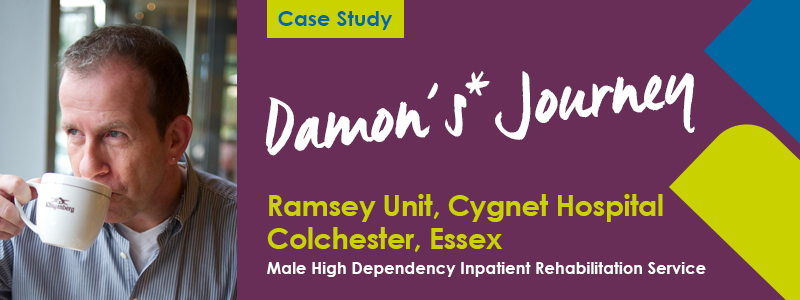
Damon’s* history
Damon struggled with emotional outbursts in his early years and was disconnected from other children, other than when they bullied him. In late adolescence, he was employed in a number of jobs and enjoyed the support of a close-knit family, but always had difficulties in relationships, including with his siblings.
He was diagnosed with Autistic Spectrum Disorder (ASD) later in life, but it was clear he had a unique view of the world. He would typically be forceful in trying to get the world and people around him to comply with his view of how things should be. In addition to ASD, his later diagnoses included schizo-affective and mixed personality disorders. His use of a range of drugs in his early 20’s, including amphetamines and cannabis, may have exacerbated a certain paranoia in his relations with others.
Damon’s understanding of what people needed from him was limited and he often felt angry at his inability to control the way others behaved. This led to a number of convictions linked to his aggressive and threatening behaviour and attempts to control people around him. In his 20’s, following a violent offence, he was remanded in a high secure hospital where he spent most of the subsequent 25 years.
When Damon came to us
Damon came to us in his 50’s from a medium secure service where, finally, he had benefited from interventions by a team with some expertise in working with ASD. Unfortunately, a subsequent step-down placement in a locked rehabilitation service had broken down through no fault of his own, which sadly undid a lot of the previous few years’ positive work. Damon settled back down after his return to the medium secure setting – twice he had been assaulted by others and had resisted the desire to retaliate, and his sexual inappropriateness with female staff had reduced significantly. He was ready to recommence his journey back toward the community.
Following admission, Damon’s complaints about staff on Ramsey Unit began and quickly escalated in frequency and degree. He would be particularly aggrieved if a consultant used the wrong phrase in his notes when describing something Damon had said, or if a nurse had planned to meet him at a particular time but arrived a minute or so late.
Damon’s care
It was clear very quickly that without significant thought and care about how to respond to Damon’s concerns, relationships and any therapeutic rapport would suffer. Luckily, the team on Ramsey are particularly keen on coproduction, and so were able to work on this collaboratively. A typical way of fielding his complaints was to remind Damon that we all want a perfect world, and ask ‘so what changes can we work on together to make some progress toward that?’
On this basis, the Multi-disciplinary team (MDT) were able to start gently challenging Damon’s black-and-white view of the world. They encouraged him to challenge his initial thoughts about the intentions of others; perhaps it was an accident when someone knocked into you in the corridor, rather than an assault; and, more importantly, what shall we do about it together?
The rigidity in Damon’s thinking was, at times, challenging to work with. His elevated and then depressed mood, together with his black-and-white views, seemed typical of someone with bi-polar illness (as had previously been diagnosed) or schizo-affective disorder as now understood.
The near absence of interpersonal boundaries and ability to conceive of other people as people, together with his grandiosity, was typical of his mix of personality disorders. But the Ramsey team found that constantly bringing themselves back to thinking and talking about Damon as a person, rather than a cluster of diagnoses and problems, kept them grounded in the relationship with him and helped maintain a positive connection.
Damon’s stance in Occupational Therapy sessions challenged his therapist to find a different way of working with him. He would try to take control of the sessions, teaching others some of the skills he had learnt. Whilst sometimes difficult, the team found this useful as a way to keep true to their coproduction ethos. Damon became a significant asset in role modelling service user empowerment including reviewing and revising policies on the ward.
As Damon learned to collaborate, he also improved his skills in activities of daily living. The Ministry of Justice (MoJ) recognised this and agreed to his having escorted, then shadowed, and later unescorted leave. Unsurprisingly, after nearly three decades in secure psychiatric services there was an element of institutionalisation in Damon’s outlook, compounding his autistic traits. A concern emerged after reviewing his use of leave, that his inappropriateness with women might still be a risk factor.
However, spending his entire unescorted leave in a bus shelter near the hospital turned out to be a way he could ensure he took exactly four hours leave as prescribed. The team helped him think about breaking up those four hours into several different bits, and using the leave to go walking or cycling.
Damon latched onto the idea of ‘cutting strings’ to his emotions when they threatened to overwhelm him, or when he might otherwise have immersed himself in them. Psychotherapy, he said, helped him cut those strings. It proved a very successful means of him standing back from a feeling or stance, and tolerating uncertainty, or multiple perspectives.
Damon today
At his recent Tribunal hearing, the judge intimated that if a suitable placement in the community can be found, Damon is likely to be discharged from detention under the Mental Health Act. Damon feels sorry for what he has done in the past and doesn’t want to repeat it. In part this is because he doesn’t want to return to hospital once he leaves, but his regret appears to goes further than that. He doesn’t want to be the person he was any more. The relentlessly collaborative approach of the team has shown Damon there is another way to be.
Damon has been able to reflect on some of his actions, for example suggesting the team were fraudulently keeping records after noting his mood was ‘good’ even though he had said he felt ‘fantastic’. He now understands how to better express concerns like this, and that sometimes he might misinterpret situations.
Damon enjoys helping to plan groups and gets enormous satisfaction from being part of others’ recovery. He also has a developing sense of humour – he grins these days when making a complaint, or interrupting the Unit Manager on the phone to CQC to ask politely if he might have a word with the inspector when they have finished their conversation.
It has been three years since any incidents of violence. Damon has been rehearsing scenarios around potential triggers in the community, ready for his return there. It is evident that he is immensely satisfied to know he is handling things well, and the team are confident this will remain a powerful protective factor, along with the interpersonal skills Damon has learnt. Together they are enjoying planning Damon’s discharge.
*Name has been changed to protect his identity




